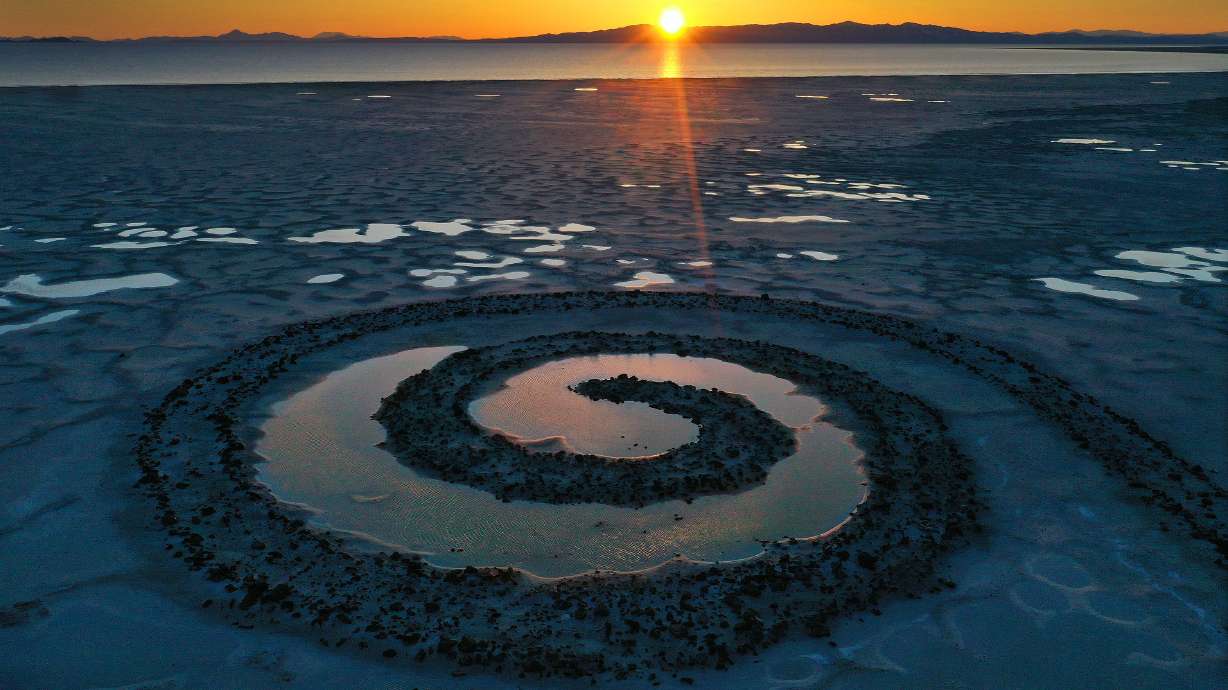Sometimes art makes you go, “Hmm, that’s nice.” And sometimes it makes you go, “Hmm … what?” Landscapes have inspired artists for a long time, and that is certainly the case with these iconic pieces of land art in Utah.
Upon first look, you may be scratching your head. But further investigation — and maybe a meditative think or two — enlightens you to the inspiration and meaning behind the art. Check out the land art that enhances (or contrasts) Utah’s landscapes in their own weird way.
The Tree of Utah“Metaphor: The Tree of Utah” stands at the edge of the Bonneville Salt Flats in western Salt Lake County. (Photo: Tom Kelly, Creative Commons)
West of the Great Salt Lake sits Karl Momen’s 1980s creation Metaphor: The Tree of Utah, sometimes called The Tree of Life. This abstract piece sits on the edge of I-80 and the Bonneville Salt Flats, making for a memorable sight on the empty drive between Salt Lake City and Wendover. Its cement pillar and giant colorful spheres stand nearly 90 feet tall and serve as a reminder that life can be found in the most barren of places.
Gilgal Gardens
Let’s go for a stroll and say “hi” to the neighborhood sphinx, shall we? The bizarre structures at Gilgal Sculpture Garden can be found on a quieter downtown street in Salt Lake City.
A sphinx with the face of Joseph Smith greets visitors at Gilgal Garden, at 452 S. 800 East, in Salt Lake City. (Photo: Gary M. McKellar, Deseret News)
But bizarre seems inadequate to describe what you’ll see — poetry scribed into stone, unnerving (or inspiring) depictions of scripture, a human heart sculpture, and of course, the legendary sculpture of Joseph Smith as a sphinx. Thomas Battersby Child Jr. created Gilgal as a place where visitors can ponder the earth’s unsolved mysteries and find something that suits them best.
Sun Tunnels
There are many beliefs when it comes to the placements of the sun, moon and stars, but the Sun Tunnels in the Great Basin Desert capture some cosmic magic that anyone can appreciate.
On June 21, 2018, the sun rises on the horizon at the northernmost point of the solar cycle. At sunrise and sunset on that day, the sun touches the horizon at a point perfectly centered on an imaginary line drawn through two of the tunnels. The Sun Tunnels are an iconic work of modern art created in the 1970s by sculptor Nancy Holt, who died in 2014. (Photo: John Hollenhorst, KSL-TV)
Artist Nancy Holt built the Sun Tunnels from concrete, with holes drilled in patterns after the Draco, Perseus, Columba and Capricorn star constellations. The tunnels are arranged in a cross pattern so that two of them perfectly frame the sun as it rises and sets during the summer and winter solstices. Talk about a divine sight.
Spiral JettyThe sun sets on the Spiral Jetty on the Great Salt Lake on March 16, 2023. (Photo: Jeffrey D. Allred, Deseret News)
We all know the ’70s inspired some trippy art.
The Spiral Jetty on the Great Salt Lake’s northern shore is no exception. Sculptor Robert Smithson created this piece of land art with a combination of basalt stones, mud and salt crystals to form a counterclockwise spiral in the water. To really understand what the piece is all about, his complementary film, “Spiral Jetty,” explains the influence from his interests in geology, paleontology, astronomy and mythology.
Ratio and Elements
The golden rule of road trips is that you stop at any photo op site along the way. Just off I-70 in Green River is the perfect spot — Ratio and Elements by Andrew Rogers. Ratio is a 50-foot pile of cement blocks that was based on the golden ratio commonly found in nature.
Close by is Elements. It consists of four 132-foot-high pillars, with one topped in 23-karat gold, and all representing the four elements: fire, earth, water and wind.
MonolithA mysterious sculpture appeared in the most unlikely place in 2020 before it was removed and appeared again outside Las Vegas in 2024. (Photo: Associated Press)
Although no longer standing, the Utah monolith deserves a mention as a notable example of land art with a lesson. It was discovered in a remote San Juan County slot canyon by biologists in 2020, piquing the curiosity of nearly everyone in Utah. A triangular mirrored statue mysteriously appears out of nowhere? In the middle of nowhere? What could it mean? How did it get there? Who is responsible for it? Folks obviously wanted to investigate.
Alas, it was unlawfully placed on public land and was removed. An influx of foot traffic to the monolith could have led to ill-informed or ill-intentioned citizens damaging Native American sites and the surrounding terrain. So, let this piece serve as a reminder that although nature is inspiring, we should first be stewards of the land that inspired us and leave it vandalism-free.
Have you been to any of these land art locations in Utah? Leave us a comment and let us know which one is your favorite.

